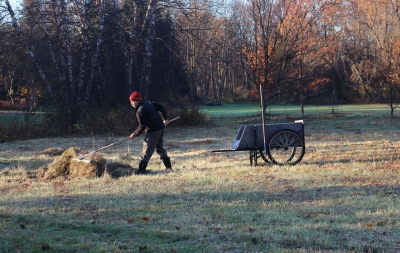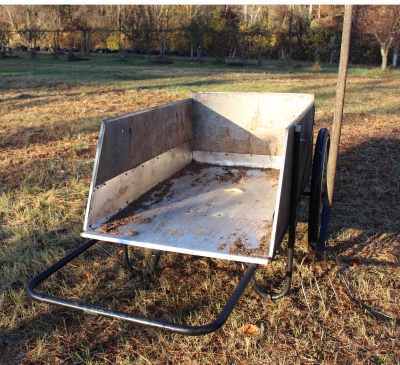SUSTAINABLE DIRT
Dirt is Free, Almost
Sustainability is such a buzzword these days. Okay, I’ll join the crowd and say, “I’m growing fruits and vegetables sustainably.” But is this true. Can they really be grown sustainably, that is, in such a way to be able to continue forever?
As any plant grows, it sucks nutrients from the soil. Harvest the plant and you take those nutrients off-site. Eventually, those nutrients need replenishment. That’s what fertilizer does, but spreading fertilizer — whether organic or chemical — is hardly sustainable. Organic fertilizers, such as soybean meal, need to be grown, harvested (taking nutrients off site), processed, bagged, and transported. Chemical fertilizers need to be mined and processed, or manufactured, and then also bagged and transported.
About half the volume of most soils is mineral, the rest being air, water, and organic matter. The mineral portion derives from rocks that, with time, temperature changes, and the jostling and chemical action of plant roots, fungi, earthworms, and other soil microorganisms, are ground finer and finer. Plant nutrients once locked up in those rocks become soluble and available to plants. Over time, a soil naturally offers a pretty much unlimited supply of plant nutrients. That sounds sustainable . . . but wait; three important caveats.
First, it takes time to release those nutrients. Remove too much too fast and it’s like taking money out of the bank faster than you put it in.
Second, one very important nutrient, nitrogen, does not come from rocks. It comes from the air, “fixed” by soil microorganisms, then incorporated into plants. As plants die, the nitrogen is incorporated into the organic fraction of the soil, from which it is slowly released into the ground for other plants to use — unless it washes away or becomes a gas again. Nitrogen is the most evanescent of plant nutrients.
And third, a soil could be naturally lacking in one or more essential plant nutrients. If so, the deficiency needs to be corrected by bringing in and spreading what’s needed.
Hay, Time, & a Little Manure
Okay, here’s my stab at sustainability: My vegetables get “fed” only compost, a one-inch depth laid on top of each bed each year. This much compost releases enough nitrogen, as well as other nutrients, to keep plants happy and healthy for a year.
But the sustainability meter must examine what goes into the compost. The bulk of my compost is made from hay harvested from my one acre hayfield. Here’s the rub: If I harvest the hay too frequently, I’m mining the soil, pulling out nutrients faster than they are naturally replenished. So I focus on different parts of the field in different years, giving previously harvested portions time to rejuvenate.
Early morning forays into the field with my scythe provide enough hay for compost making during the growing season. Last week, I did what I do each fall, attaching the brush hog to my tractor and mowing the whole field. (Mostly, this prevents the field from morphing over time, first to a field of brambles, multiflora roses, and autumn olives, and then on to forest.) After brush hogging, I rake up a few clumps of hay here and there for the final “feeding” of the season’s compost piles.
This end-of-season stuff is not very nutrient-rich, so what little I harvest takes little from the field in terms of nutrients. This cutting mostly supplies carbon compounds, which it got from via photosynthesis from carbon dioxide, to feed the compost microorganisms.
Keeping an eye on the character of the hayfield should give me some idea of how it’s doing nutritionally. More grasses, more nutrients. Areas of goldenrod, yarrow, and other forbs get mowed, but not raked.
My compost pile also gets fed horse manure that I haul in from a local stable. My use of manure is sustainable only in the sense that it’s someone else’s waste product. Other additions to my compost pile are kitchen scraps and spent garden plants (which recycles rather than adds nutrients), and old blue jeans and other biodegradable clothing. Using humanure (see The Humanure Handbook by Joseph Jenkins), if I had a composting toilet, would further close the nutrient cycle.
Two final additions, sustainable except that they need to be transported here, are ground limestone and kelp. The limestone holds soil acidity near neutral, which, among other benefits, puts nutrients in forms most accessible to plants. The kelp, replete with a spectrum of micronutrients, is for insurance, just in case my soil naturally lacks any essential plant (or human) nutrient.
And Now for the Cart’s Sustainability
Hay is bulky stuff; same goes for manure. I move all that bulky stuff to my compost piles, then move the finished compost away from the piles. All this moving is done with the help of my “Vermont garden cart,” which has two heavy duty, bicycle-sized tires sitting just about midway across a sturdy plywood bed surrounded by three sturdy plywood walls. Although the cart can haul up to 400 pounds, shoveling out manure or compost scrapes away at the plywood base. That, along with jabs from the pitchfork as I pile in hay severely compromised the wood . . . until this summer.
A sheet of aluminum, a friend’s brake for making sharp bends in the sheet, and some screws, and I had the bottom of the cart, and a few inches up each side, protected from my shovel, pitchfork, and moisture. These carts should be sold already aluminized.
The only problem is that aluminum is very unsustainable. Although abundant, enormous amounts of electricity are required to free it from the raw material, bauxite. On the plus side, aluminum is very long-lasting; I’ll never have to replace it in my carts.



